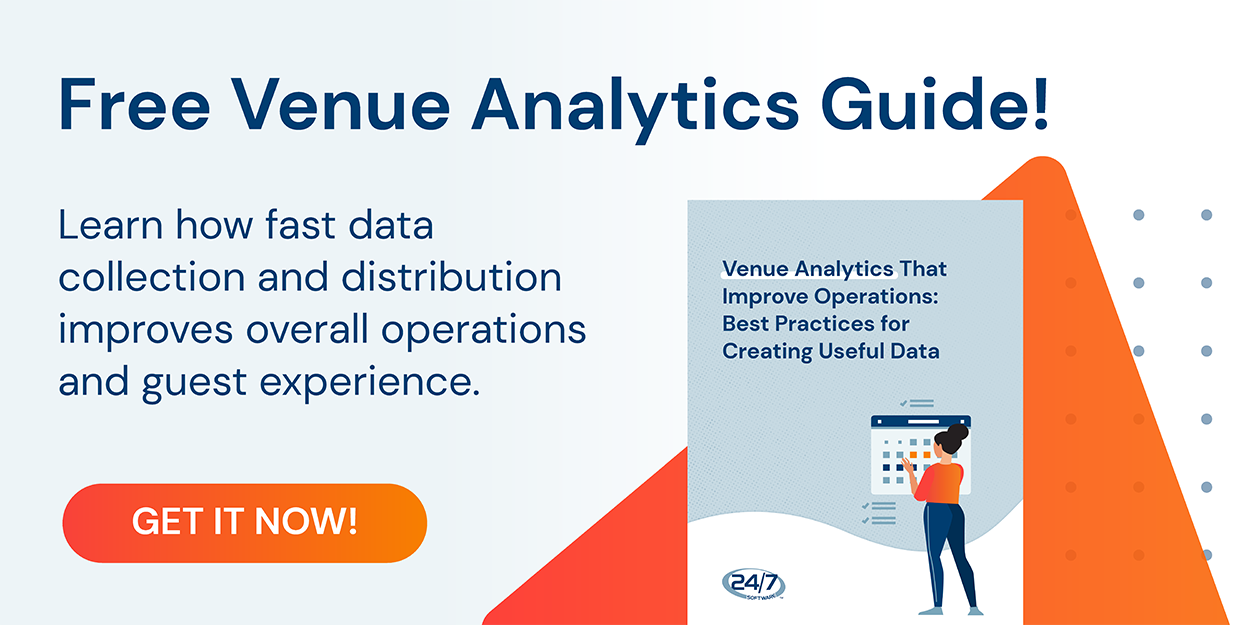“You can’t manage what you don’t know.”
We’ve said it before and we’ll say it again. It’s one of the most important aspects to understanding and improving your operation.
Yet, why does it get often overlooked? We’ve had our theories for quite some time.
- You’re too busy to take the time to look at your data
- Your staff isn’t collecting complete and accurate documentation
- Your team is not fully aware of what’s actually going on at your property
- The communication between your departments is limited or in a state of non-existence
After watching a recent 60 Minutes interview with NFL Commissioner, Rodger Goodell, about concussions – it hit us. The NFL is actively exploring the concussion problem by making an investment in research and then using the data to effectively change the result.
Harness the power of venue analytics. →
What really got us thinking is this one comment he made: “We want the facts. We think the facts will help us develop better solutions.”
That, along with the fact that they’re investing in this initiative, led us to realize the problem in this industry is that all of our theories are affecting how professional operations better understand efficiency and effectiveness.
It’s that all of these stem from one major factor threatening the welfare of an operation like yours. Do you know what the answer to this puzzle is? We think we solved it for you.
It’s a multipart challenge that can be resolved by investing in a solution, building an infrastructure to support it, collecting the insightful data, and – most important – using it to improve your operation.
Investing in a solution and actually using it!
It’s time for you to get the facts, so invest in the right solution like an incident management system for better analysis of your operation. Because, we’re going to help you build an infrastructure conducive of developing better outcomes for your operation.
Are you ready? Let’s dive in.
Structure Leads to Facts You Can Use
Are you currently using an incident management system? Or, are you just about to put on in place? What’s your current setup?
Do you have an infrastructure in place that’ll increase your awareness, enhance communication, lead to accurate documentation, and will provide you with analytics you can use to ‘get the facts’?
Frankly, are you able to collect all of the data that you need? Are you set up the right way so that everything gets tracked?
If you’re not sure or you know the answer is a resounding “No!” – keep reading because today we’re going to help you achieve peace of mind.
At this point, we know you’re not getting the essential, measurable, and useful data you need to succeed as a professional.
As you probably know, logging incidents into a solution is only the beginning.
You’re investing in a solution, so let’s put you in a position to use it and use it better. Do this so you can get all the analytics you need to give you, your staff, and boss peace of mind.
An Infrastructure Supports Your Solution & Useful Analytics
To get useful data, you must give your staff the ability to communicate, collect, and manage information efficiently and effectively.
This will give you the best foundation for achieving results.
Here’s an infrastructure you can use, cohesively with the solution you’ve invested in, to get facts that you need for improving your operation.
It starts with who’s involved and includes staff from every department an incident or issue can be associated with.
How to Manage Front of House Needs
This is where you’ll be spending your time on event day. Ideally, you and your front of house staff will centralize in a location that allows a visual of your entire property – the command center.
These front of house staff might include Police, Fire Rescue, Event Security, Parking Operations, Guest Services, and a central Dispatcher, depending on your property’s needs.
Each of your departmental staff needs to have the ability to view and manage their own department’s dispatch queue, from their own computer within the command center.
All incident details should be able to be viewed and managed simultaneously by all departments.
Each department should have their own segmented dispatch screen so that they can focus on their incidents while your Dispatcher can keep an eye out on the big picture.
From high priority incidents to lost items, this is what we call instant communication!
Your central dispatcher will monitor a single radio channel for incoming communications. This method reduces radio traffic and allows all representatives in the command center to receive calls-for-service and incident details from one source.
Harness the power of venue analytics. →
How the Back of House Can Support Your Operation
Your back of house command center is set up as a separate entity to mitigate noise and confusion. This segmentation enhances effective communication, which leads to useful facts for your later analysis.
Arming your back of house staff with their own central dispatcher, who also monitors a single radio channel for all back of house incoming communications, drastically unclogs communication lines.
Your back of the house staff might include your IT department, Facility Maintenance, Housekeeping, Concessions, and a central Dispatcher for a clear communication line.
Having and using two command centers gives you the ability to effortlessly create incident or issue records for the back of house departments and front of the house.
By separating those dispatch channels, you can use your solution to remove all communication roadblocks, which left in place, will prevent you from knowing what you need to manage.
Your Infrastructure Helps You Achieve Peace of Mind
The questions of “Why to invest in a solution?” and “Why to put an infrastructure in place?” can simply be answered with this…
Analytics!
Building an infrastructure will give you the important analytics you need to use in order to completely understand your operational effectiveness, and how to improve it for better future outcomes.
Create a structure that leads to important facts and use them to attain peace of mind.
Instant Communication Leads to Real-Time Data
The days of dispatching your team and not receiving status updates are gone.
With your infrastructure in place, you have the right communication lines open.
- Instant communication of vital information.
- Multiple staff in multiple locations talking to each other with limited or zero
- Department segmentation with purpose, organization, and clearer initiatives for each.
Now your team can quickly and effectively manage, track, and collect the details of an incident or issue, from start to finish.
Simply put, your real-time data is the effect of real-time communication. No more missed information. Like Goodell said, “the facts will help us develop better solutions.”
Can you guess what this real-time data leads to? That’s right, better solutions and faster response.
Real-Time Data Results in Faster Response to Issues & Incidents
You can measure and improve your response times with the infrastructure in place and in full operation. Because as we’ve said before, it’s vital to invest in a solution but even more important to use it.
How, you ask? Start receiving, collecting, and documenting data that has a purpose for improving your operation.
Answer the following questions and use your answers to create a standard for efficiency and effectiveness at your property.
- How long does it take to receive a call? From the time it takes your guests to identify an incident, send a text message via text communication and /or call it in; or for your staff to report an incident via mobile device to your central dispatcher in the command center.
- How long does it take to dispatch the incident or issue to appropriate staff? For instance, a call for a fight comes in. It’s determined there’s blood at the scene. The dispatcher must notify police, fire rescue, and notify housekeeping to come clean the area using specific procedures.
- How long does it take your responding staff to get on scene to the incident or issue? From the moment the incident or issue is dispatched to all departments, you can now effectively determine the length of time each associated department takes to arrive on scene from their current locations.
- How long does it take your staff to mitigate the incident and begin responding to the next? Your staff is responsible for the safety of all guests at your property. Once they close out one incident or issue, everyone’s abilities really shine when they’re able to efficiently, effectively, and expeditiously respond to the next situation with the same velocity and effectiveness.
These questions help you understand appropriate response times. They’ll also give you the foresight you need to dramatically enhance your whole operation.
Continue questioning the state of your current operation based on your results – and the hard facts you’ve gathered from investing in a solution and using it.
- Do you need to increase staffing levels to promote faster response times?
- What areas or hot spots need an increase in awareness?
- Should you put more resources in hot spot locations?
- Is stress or lack of training affecting staff performance?
- Do you have trained staff in the right areas?
Consider the scenario below.
Before your infrastructure was put into place your response time to a fight was six minutes. Now, your response time to a fight decreases to two and a half minutes.
We’d argue that’s tremendous progress.
All from having and using facts. All because you've built an infrastructure for your operation that gives you reliable information, the confidence to analyze it, and the useful data to enhance your operation.
Have Data to Protect Your Property From Future Liability
Of all the benefits from your solution and infrastructure that can help you achieve peace of mind is ‘liability protection’.
With your solution and infrastructure in place, you now know what to manage – and how to improve it.
Let’s put it into perspective. The fight incident we mentioned above turns into a legal case.
You’re deposed for the case as it did occur at your property under your watch. You show up with every piece of data related to this incident.
It takes your team two and a half minutes to efficiently respond to a fight. You have the information to show your team consistently responds in that timeframe to most incidents or issues.
This demonstrates to the court that you’re properly staffed for all events at your property. It also shows your ability to provide ‘the facts’ with a digital paper trail.
You can confidently show consistent response times with a highly effective system. How much better of a result will you have in court?
Case closed. How’s that for peace of mind?
Over to You
Today, we’d like your biggest takeaway to be investing in a solution, building the right infrastructure to support it, and using this to get the facts you can analyze to continuously improve your operation.
That’s how you keep your guests safe, your property secure, and ensure peace of mind for the future.
So, will you be investing in solutions for your property and using them to get the facts you need to improve your operation?




